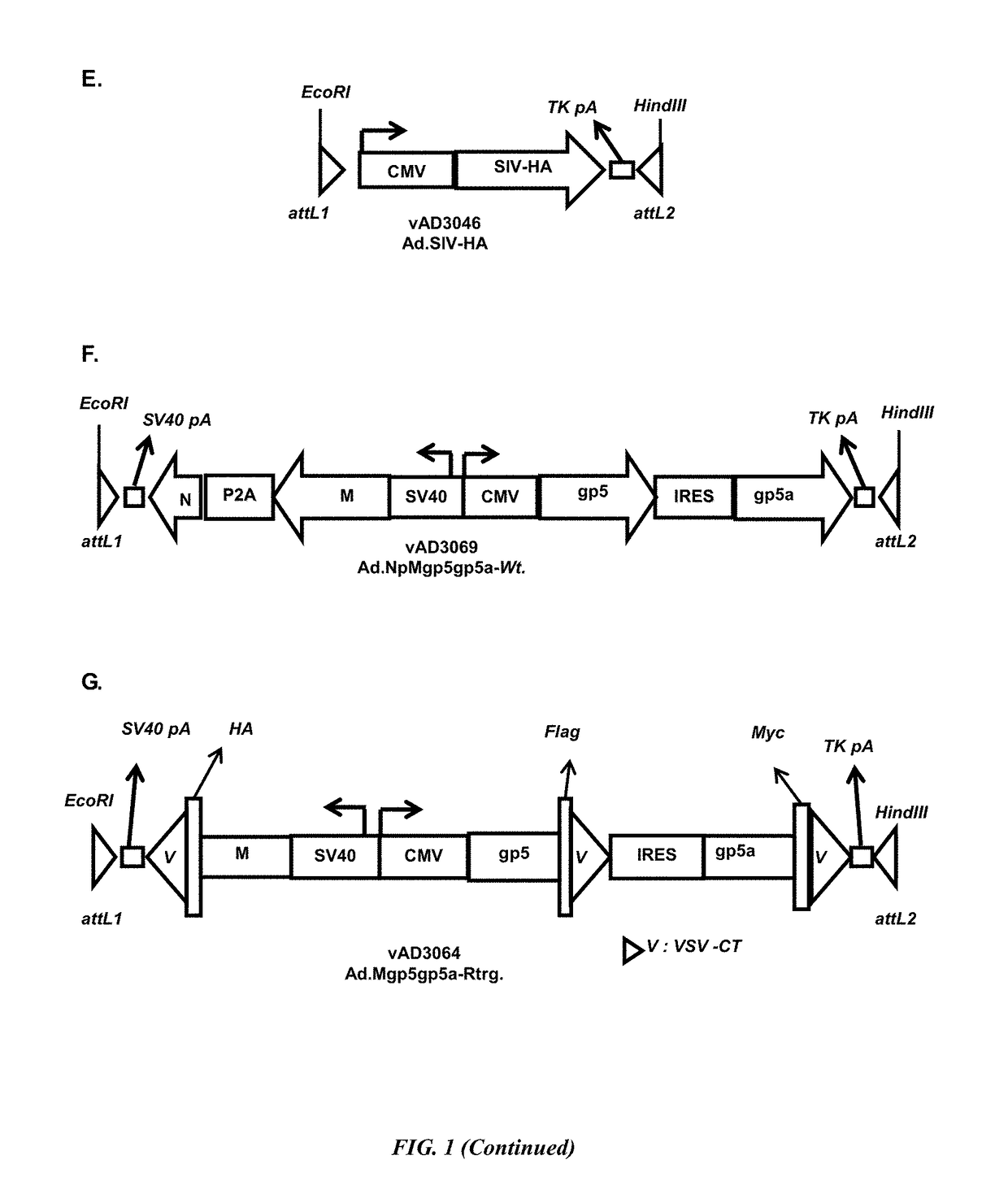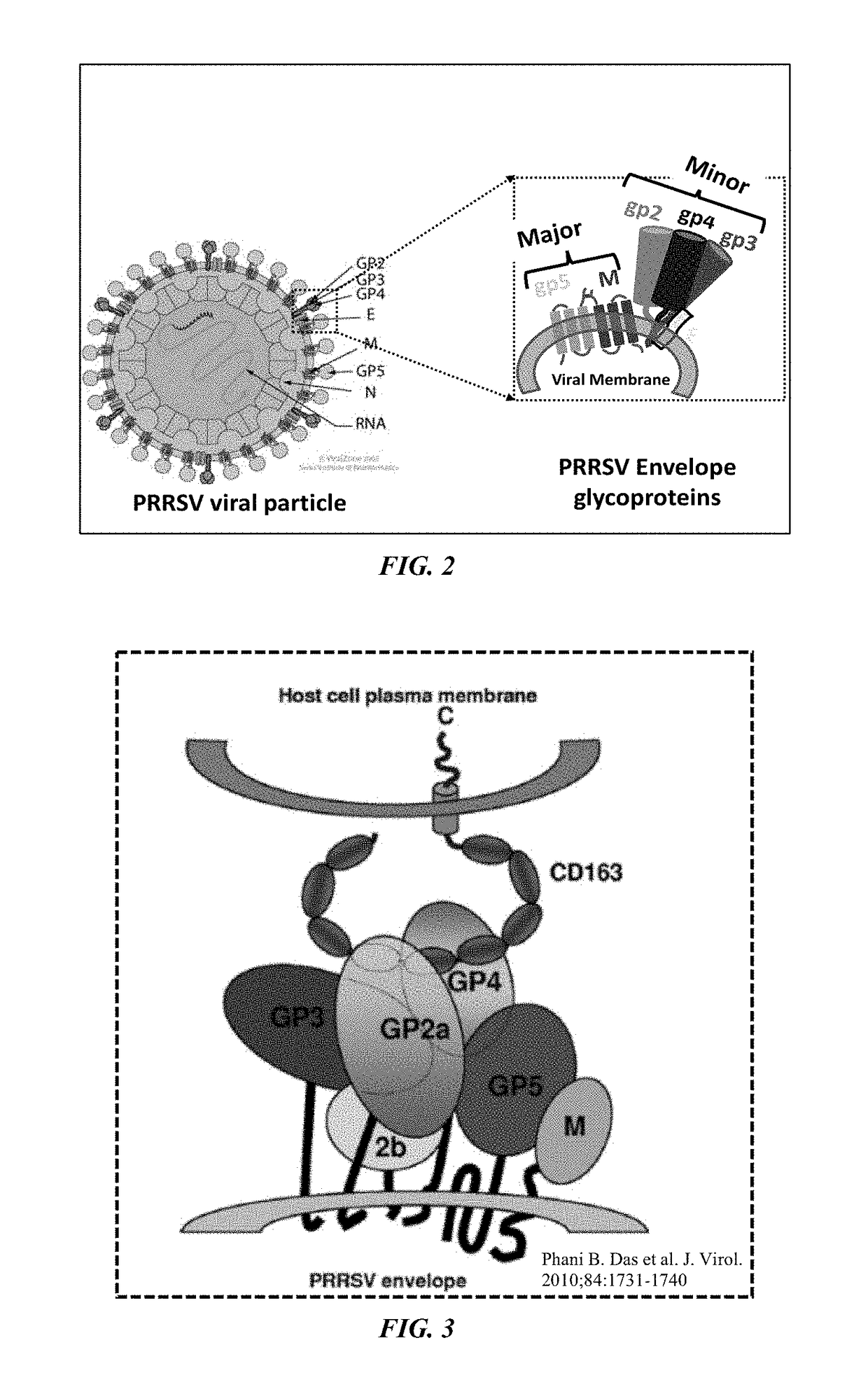PRRSV minor protein-containing recombinant viral vectors and methods of making and use thereof
a technology of recombinant adenovirus and vector, which is applied in the direction of dsdna viruses, antibody medical ingredients, peptide sources, etc., can solve the problems of fulminant infection, inability to free prrsv vaccine farms, and limited effective measures to prevent infections, etc., to achieve dramatically different protective responses, robust immune responses, and altered virus tropism
- Summary
- Abstract
- Description
- Claims
- Application Information
AI Technical Summary
Benefits of technology
Problems solved by technology
Method used
Image
Examples
example 1
ion and Testing of Plasmids Expressing PRRSV Genes
[0226]In order to increase visibility to the immune system, the PRRSV envelope proteins were re-targeted to the cell surface from intracellular compartments by introducing multiple changes while maintaining the extracellular domain (putative antibody binding site). The re-targeting of the envelope genes was initially attempted by removing the cytoplasmic and transmembrane domains of the native protein, which is probable site for the retention signal, and replacing them with similar domains from vesicular Stomatitis Virus glycoprotein (VSV-G), another viral protein known for cell surface expression. The signal sequence of the native envelope genes was also replaced with the signal sequence from tissue plasminogen activator (tPA), a well-characterized secretory protein, to promote entry of the modified proteins to the secretory pathway and eventual expression on the cell surface. Specific epitope tags were also inserted into each of th...
example 2
ccination with Pooled PRRSV Envelope Gene-Expressing Plasmids
[0234]Thirty-two, 3 weeks pigs were divided into 4 groups, of 8 animals each (Table 2).
[0235]
TABLE 2Study details.ImmunizationNo.(Days)Killed / DNAChallengeGroupAnimalsGroup0142842638418Wild-type PRRSV Gps1AXXXXDNA (3)X1BXXXXKilled (5)X28Recombinant PRRSV2AXXXXDNA (3)XGps2BXXXXKilled (5)X38Mock DNA Imm.3AXXXXDNA (3)X(Rabies G)3BXXXXKilled (3)X48Un-vaccinatedX
[0236]The wild-type group received pool of 3 plasmids expressing the non-targeted gps, the recombinant group received pool of three plasmids expressing the re-targeted gps (i.e. FIGS. 5B to 5D), the Mock group received plasmid coding for the Rabies glycoprotein, while the unvaccinated group received only Tris-EDTA buffer. Each plasmid was at a concentration of about 1 μg / μL, and about 400 μg of each plasmid was administered at 200 μl per each ear lobe. After 4 immunizations, each group was further divided and boosted with either Killed vaccine, in TS6 adjuvant (U.S. Pat....
example 3
ion and Testing of Viral Vectors Expressing PRRSV Genes
[0239]Cells and Media. HEK 293 cells (ATCC) were maintained in MEM (Gibco #11095) with 10% Fetal Bovine serum (Moregate Batch #81827101) at 37° C. in 5% CO2. These cells were used to rescue the recombinant adenovirus (vAD3041, vAD3042, vAD3038, vAD3033, and vAD3067) and make virus stocks.
[0240]Construction of Viral Vectors and Immunogens.
[0241]The minor envelope proteins of PRRSV include gp2 (ORF2), gp3 (ORF3), gp4 (ORF4) and E (ORF2b). The DNA sequence of each of these proteins was obtained from GenBank Accession #U87392 (VR2332, PRRSV Type II). VR2332 (North American strain) represents one of two known major serotypes of PRRSV (Done et al., 1996). The other, prototype Lelystad, is representative of at least most strains that have been isolated in Western Europe. The codon-optimized sequences of each protein when constructed with appropriate promoter to express all proteins from single viral vector (FIG. 1). In each case, SV40 ...
PUM
| Property | Measurement | Unit |
|---|---|---|
| weight ratio | aaaaa | aaaaa |
| weight ratio | aaaaa | aaaaa |
| time | aaaaa | aaaaa |
Abstract
Description
Claims
Application Information
 Login to View More
Login to View More - R&D
- Intellectual Property
- Life Sciences
- Materials
- Tech Scout
- Unparalleled Data Quality
- Higher Quality Content
- 60% Fewer Hallucinations
Browse by: Latest US Patents, China's latest patents, Technical Efficacy Thesaurus, Application Domain, Technology Topic, Popular Technical Reports.
© 2025 PatSnap. All rights reserved.Legal|Privacy policy|Modern Slavery Act Transparency Statement|Sitemap|About US| Contact US: help@patsnap.com



